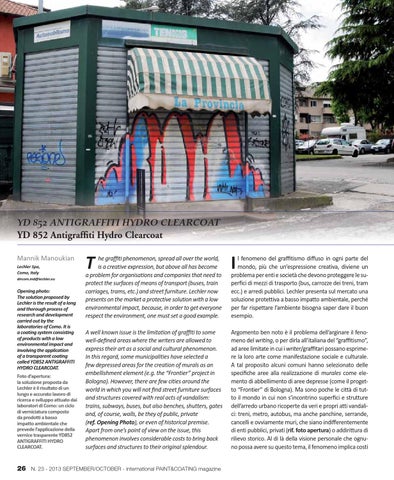YD 852 ANTIGRAFFITI HYDRO CLEARCOAT YD 852 Antigraffiti Hydro Clearcoat Mannik Manoukian Lechler Spa, Como, Italy dircom.ind@lechler.eu
Opening photo: The solution proposed by Lechler is the result of a long and thorough process of research and development carried out by the laboratories of Como. It is a coating system consisting of products with a low environmental impact and involving the application of a transparent coating called YD852 ANTIGRAFFITI HYDRO CLEARCOAT. Foto d’apertura: la soluzione proposta da Lechler è il risultato di un lungo e accurato lavoro di ricerca e sviluppo attuato dai laboratori di Como: un ciclo di verniciatura composto da prodotti a basso impatto ambientale che prevede l’applicazione della vernice trasparente YD852 ANTIGRAFFITI HYDRO CLEARCOAT.
he graffiti phenomenon, spread all over the world, is a creative expression, but above all has become a problem for organisations and companies that need to protect the surfaces of means of transport (buses, train carriages, trams, etc.) and street furniture. Lechler now presents on the market a protective solution with a low environmental impact, because, in order to get everyone respect the environment, one must set a good example.
T
l fenomeno del graffitismo diffuso in ogni parte del mondo, più che un’espressione creativa, diviene un problema per enti e società che devono proteggere le superfici di mezzi di trasporto (bus, carrozze dei treni, tram ecc.) e arredi pubblici. Lechler presenta sul mercato una soluzione protettiva a basso impatto ambientale, perché per far rispettare l’ambiente bisogna saper dare il buon esempio.
A well known issue is the limitation of graffiti to some well-defined areas where the writers are allowed to express their art as a social and cultural phenomenon. In this regard, some municipalities have selected a few depressed areas for the creation of murals as an embellishment element (e.g. the “Frontier” project in Bologna). However, there are few cities around the world in which you will not find street furniture surfaces and structures covered with real acts of vandalism: trains, subways, buses, but also benches, shutters, gates and, of course, walls, be they of public, private (ref. Opening Photo), or even of historical premise. Apart from one’s point of view on the issue, this phenomenon involves considerable costs to bring back surfaces and structures to their original splendour.
Argomento ben noto è il problema dell’arginare il fenomeno del writing, o per dirla all’italiana del “graffitismo”, ad aree limitate in cui i writer/graffitari possano esprimere la loro arte come manifestazione sociale e culturale. A tal proposito alcuni comuni hanno selezionato delle specifiche aree alla realizzazione di murales come elemento di abbellimento di aree depresse (come il progetto “Frontier” di Bologna). Ma sono poche le città di tutto il mondo in cui non s’incontrino superfici e strutture dell’arredo urbano ricoperte da veri e propri atti vandalici: treni, metro, autobus, ma anche panchine, serrande, cancelli e ovviamente muri, che siano indifferentemente di enti pubblici, privati (rif. foto apertura) o addirittura di rilievo storico. Al di là della visione personale che ognuno possa avere su questo tema, il fenomeno implica costi
26 N. 23 - 2013 SEPTEMBER/OCTOBER - international PAINT&COATING magazine
I
